Application of a ImageJ-Based Method to Measure Blood Flow in Adult Zebrafish and Its Applications for Toxicological and Pharmacological Assessments
Simple Summary
Abstract
1. Introduction
2. Materials and Methods
2.1. Animal Husbandry
2.2. Chemical Preparation
2.3. Blood Flow Velocity Validation
2.4. Power Analysis for Blood Vessel Selection
2.5. High-Speed Videography
2.6. Blood Flow Velocity Measurements
2.7. Blood Flow Velocity Measurements After Waterborne Exposure to Carbofuran and Copper Oxide
2.8. Statistical Analysis
3. Results
3.1. Blood Flow Velocity Measurements on the Blood Vessels at the Base of the Tail Fin and the Tip of the Tail Fin
3.2. Blood Flow Velocity at Different Ambient Temperatures
3.3. Sensitivity of Blood Flow Velocity to Fenpropathrin and Ponatinib
3.4. Blood Flow Velocity in Copper Oxide- and Carbofuran-Exposed Zebrafish
3.5. Blood Flow Velocity Measurements in Other Fish Species
4. Discussion
5. Conclusions
Supplementary Materials
Author Contributions
Funding
Institutional Review Board Statement
Informed Consent Statement
Data Availability Statement
Conflicts of Interest
References
- Polak-Iwaniuk, A.; Harasim-Symbor, E.; Gołaszewska, K.; Chabowski, A. How hypertension affects heart metabolism. Front. Physiol. 2019, 10, 435. [Google Scholar] [CrossRef] [PubMed]
- Huang, Y.; Hu, D.; Huang, C.; Nichols, C.G. Genetic discovery of ATP-sensitive K+ channels in cardiovascular diseases. Circ. Arrhythmia Electrophysiol. 2019, 12, e007322. [Google Scholar] [CrossRef]
- Zhang, H.; Barralet, J.E. Mimicking oxygen delivery and waste removal functions of blood. Adv. Drug Deliv. Rev. 2017, 122, 84–104. [Google Scholar] [CrossRef] [PubMed]
- Benveniste, H.; Lee, H.; Volkow, N.D. The glymphatic pathway: Waste removal from the CNS via cerebrospinal fluid transport. Neuroscientist 2017, 23, 454–465. [Google Scholar] [CrossRef]
- John, L.M. The cardiovascular system. In Biomaterials, Artificial Organs and Tissue Engineering; Hench, L.L., Jones, J.R., Eds.; Woodhead Publishing: Boca Raton, FL, USA, 2005; pp. 90–96. [Google Scholar] [CrossRef]
- Do Amaral, J.A.; Guida, H.L.; De Abreu, L.C.; Barnabé, V.; Vanderlei, F.M.; Valenti, V.E. Effects of auditory stimulation with music of different intensities on heart period. J. Tradit. Complement. Med. 2016, 6, 23–28. [Google Scholar] [CrossRef] [PubMed]
- Gierthmuehlen, M.; Plachta, D.T. Effect of selective vagal nerve stimulation on blood pressure, heart rate and respiratory rate in rats under metoprolol medication. Hypertens. Res. 2016, 39, 79–87. [Google Scholar] [CrossRef] [PubMed]
- Mayet, J.; Hughes, A. Cardiac and vascular pathophysiology in hypertension. Heart 2003, 89, 1104–1109. [Google Scholar] [CrossRef]
- Wenceslau, C.F.; McCarthy, C.G.; Earley, S.; England, S.K.; Filosa, J.A.; Goulopoulou, S.; Gutterman, D.D.; Isakson, B.E.; Kanagy, N.L.; Martinez-Lemus, L.A.; et al. Guidelines for the measurement of vascular function and structure in isolated arteries and veins. Am. J. Physiol. Heart Circ. Physiol. 2021, 321, H77–H111. [Google Scholar] [CrossRef] [PubMed]
- Cooney, M.T.; Vartiainen, E.; Laakitainen, T.; Juolevi, A.; Dudina, A.; Graham, I.M. Elevated resting heart rate is an independent risk factor for cardiovascular disease in healthy men and women. Am. Heart J. 2010, 159, 612–619.e3. [Google Scholar] [CrossRef] [PubMed]
- Cornelissen, V.A.; Fagard, R.H. Effects of endurance training on blood pressure, blood pressure–regulating mechanisms, and cardiovascular risk factors. Hypertension 2005, 46, 667–675. [Google Scholar] [CrossRef] [PubMed]
- Ahmed, H.; Podder, C. Hemodynamical behavior analysis of anemic, diabetic, and healthy blood flow in the carotid artery. Heliyon 2024, 10, e26622. [Google Scholar] [CrossRef]
- Kajiya, F.; Onodera, K.; Maruyama, Y.; Klassen, G.A.; Tomoike, H.; Spaan, J.A.E.; Tsujioka, K.; Hoffman, J.I.E. Coronary Circulation: Basic Mechanism and Clinical Relevance; Springer: Tokyo, Japan, 2012. [Google Scholar]
- Juneau, M. Cardiovascular Health: Living Your Best with a Healthy Heart; Dundurn Press: Toronto, ON, Canada, 2018. [Google Scholar]
- Ribatti, D.; Nico, B.; Crivellato, E. The development of the vascular system: A historical overview. Vasc. Morphog. Methods Protoc. 2015, 1214, 1–14. [Google Scholar]
- Taal, M.W.; Chertow, G.M.; Marsden, P.A.; Skorecki, K.; Yu, A.S.L.; Brenner, B.M. Brenner and Rector’s the Kidney E-Book; Elsevier Health Sciences: Amsterdam, The Netherlands, 2011. [Google Scholar]
- Namisnak, L.H.; Haghayegh, S.; Khoshnevis, S.; Diller, K.R. Bioheat transfer basis of human thermoregulation: Principles and applications. J. Heat Transf. 2022, 144, 031203. [Google Scholar] [CrossRef] [PubMed]
- Katz, A.M. Physiology of the Heart; Lippincott Williams & Wilkins: Philadelphia, PA, USA, 2010. [Google Scholar]
- Mulvagh, S.L.; Mullen, K.-A.; Nerenberg, K.A.; Kirkham, A.A.; Green, C.R.; Dhukai, A.R.; Grewal, J.; Hardy, M.; Harvey, P.J.; Ahmed, S.B. The Canadian women’s heart health alliance atlas on the epidemiology, diagnosis, and management of cardiovascular disease in women—Chapter 4: Sex-and gender-unique disparities: CVD across the lifespan of a woman. CJC Open 2022, 4, 115–132. [Google Scholar] [CrossRef] [PubMed]
- Julie, M.N.; Hüseyin, L.; Gökhan, M.M. Cardiac and cardiovascular assessment. In Encyclopedia of Sleep and Circadian Rhythms, 2nd ed.; Kushida, C.A., Ed.; Academic Press: Cambridge, MA, USA, 2023; pp. 442–447. [Google Scholar] [CrossRef]
- Heinz-Taheny, K.M. Cardiovascular physiology and diseases of amphibians. Vet. Clin. N. Am. Exot. Anim. Pract. 2009, 12, 39–50. [Google Scholar] [CrossRef] [PubMed]
- Sherrill, J.; Weber III, E.S.; Marty, G.D.; Hernandez-Divers, S. Fish cardiovascular physiology and disease. Vet. Clin. N. Am. Exot. Anim. Pract. 2009, 12, 11–38. [Google Scholar] [CrossRef] [PubMed]
- Šolc, D. The heart and heart conducting system in the kingdom of animals: A comparative approach to its evolution. Exp. Clin. Cardiol. 2007, 12, 113. [Google Scholar] [PubMed]
- Caro, C.G.; Pedley, T.J.; Schroter, R.C.; Seed, W.A. The Mechanics of the Circulation; Cambridge University Press: Cambridge, UK, 2012. [Google Scholar]
- Dunmire, B.; Beach, K.; Labs, K.; Plett, M.; Strandness, D., Jr. Cross-beam vector Doppler ultrasound for angle-independent velocity measurements. Ultrasound Med. Biol. 2000, 26, 1213–1235. [Google Scholar] [CrossRef]
- Leow, C.H.; Bazigou, E.; Eckersley, R.J.; Alfred, C.; Weinberg, P.D.; Tang, M.-X. Flow velocity mapping using contrast enhanced high-frame-rate plane wave ultrasound and image tracking: Methods and initial in vitro and in vivo evaluation. Ultrasound Med. Biol. 2015, 41, 2913–2925. [Google Scholar] [CrossRef]
- Fadnes, S.; Nyrnes, S.A.; Torp, H.; Lovstakken, L. Shunt flow evaluation in congenital heart disease based on two-dimensional speckle tracking. Ultrasound Med. Biol. 2014, 40, 2379–2391. [Google Scholar] [CrossRef] [PubMed]
- Jaiswal, K.B.; Meenpal, T. Heart rate estimation network from facial videos using spatiotemporal feature image. Comput. Biol. Med. 2022, 151, 106307. [Google Scholar] [CrossRef] [PubMed]
- Santoso, F.; Sampurna, B.P.; Lai, Y.-H.; Liang, S.-T.; Hao, E.; Chen, J.-R.; Hsiao, C.-D. Development of a simple ImageJ-based method for dynamic blood flow tracking in zebrafish embryos and its application in drug toxicity evaluation. Inventions 2019, 4, 65. [Google Scholar] [CrossRef]
- EU. E.U. Directive. Available online: https://eur-lex.europa.eu/LexUriServ/LexUriServ.do?uri=OJ:L:2010:276:0033:0079:en:PDF (accessed on 25 December 2024).
- National Research Council. Guide for the Care and Use of Laboratory Animals. Available online: https://grants.nih.gov/grants/olaw/guide-for-the-care-and-use-of-laboratory-animals.pdf (accessed on 25 December 2024).
- Xu, X.; Richard, W.D.; Feng, C.; Johnson, J.A.; Shung, K.K.; Sun, L. A high-frame rate duplex ultrasound biomicroscopy for small animal imaging in vivo. IEEE Trans. Biomed. Eng. 2008, 55, 2039–2049. [Google Scholar]
- Kim, T.N.; Goodwill, P.W.; Chen, Y.; Conolly, S.M.; Schaffer, C.B.; Liepmann, D.; Wang, R.A. Line-scanning particle image velocimetry: An optical approach for quantifying a wide range of blood flow speeds in live animals. PLoS ONE 2012, 7, e38590. [Google Scholar] [CrossRef] [PubMed]
- Liu, T.-Y.; Lee, P.-Y.; Huang, C.-C.; Sun, L.; Shung, K.K. A study of the adult zebrafish ventricular function by retrospective Doppler-gated ultrahigh-frame-rate echocardiography. IEEE Trans. Ultrason. Ferroelectr. Freq. Control 2013, 60, 1827–1837. [Google Scholar] [CrossRef]
- Huang, C.-C.; Su, T.-H.; Shih, C.-C. High-resolution tissue Doppler imaging of the zebrafish heart during its regeneration. Zebrafish 2015, 12, 48–57. [Google Scholar] [CrossRef]
- Ambrus, R.; Strandby, R.B.; Svendsen, L.B.; Achiam, M.P.; Steffensen, J.F.; Søndergaard Svendsen, M.B. Laser speckle contrast imaging for monitoring changes in microvascular blood flow. Eur. Surg. Res. 2016, 56, 87–96. [Google Scholar] [CrossRef]
- Ho-Chiang, C.; Huang, H.; Huang, C.-C. High-frequency ultrasound deformation imaging for adult zebrafish during heart regeneration. Quant. Imaging Med. Surg. 2020, 10, 66. [Google Scholar] [CrossRef] [PubMed]
- Espíndola, D.; DeRuiter, R.M.; Santibanez, F.; Dayton, P.A.; Pinton, G. Quantitative sub-resolution blood velocity estimation using ultrasound localization microscopy ex-vivo and in-vivo. Biomed. Phys. Eng. Express 2020, 6, 035019. [Google Scholar] [CrossRef] [PubMed]
- Fathi, F.; Mazdeyasna, S.; Singh, D.; Huang, C.; Mohtasebi, M.; Liu, X.; Haratbar, S.R.; Zhao, M.; Chen, L.; Ulku, A.C.; et al. Time-resolved laser speckle contrast imaging (TR-LSCI) of cerebral blood flow. IEEE Trans. Med. Imaging 2024. [Google Scholar] [CrossRef]
- Zeng, X.-X.I.; Zhong, T.P. Zebrafish. In Encyclopedia of Cardiovascular Research and Medicine; Vasan, R.S., Sawyer, D.B., Eds.; Elsevier: Amsterdam, The Netherland, 2018. [Google Scholar]
- Gut, P.; Reischauer, S.; Stainier, D.Y.; Arnaout, R. Little fish, big data: Zebrafish as a model for cardiovascular and metabolic disease. Physiol. Rev. 2017, 97, 889–938. [Google Scholar] [CrossRef]
- Du, Z.-C.; Xia, Z.-S.; Zhang, M.-Z.; Wei, Y.-T.; Malhotra, N.; Saputra, F.; Audira, G.; Roldan, M.J.M.; Hsiao, C.-D.; Hao, E.-W.; et al. Sub-lethal camphor exposure triggers oxidative stress, cardiotoxicity, and cardiac physiology alterations in zebrafish embryos. Cardiovasc. Toxicol. 2021, 21, 901–913. [Google Scholar] [CrossRef]
- Lin, H.-C.; Saputra, F.; Audira, G.; Lai, Y.-H.; Roldan, M.J.M.; Alos, H.C.; Aventurado, C.A.; Vasquez, R.D.; Tsai, G.-J.; Lim, K.-H.; et al. Investigating Potential Cardiovascular Toxicity of Two Anti-Leukemia Drugs of Asciminib and Ponatinib in Zebrafish Embryos. Int. J. Mol. Sci. 2022, 23, 11711. [Google Scholar] [CrossRef] [PubMed]
- Saputra, F.; Uapipatanakul, B.; Lee, J.-S.; Hung, S.-M.; Huang, J.-C.; Pang, Y.-C.; Muñoz, J.E.R.; Macabeo, A.P.G.; Chen, K.H.-C.; Hsiao, C.-D. Co-treatment of copper oxide nanoparticle and carbofuran enhances cardiotoxicity in zebrafish embryos. Int. J. Mol. Sci. 2021, 22, 8259. [Google Scholar] [CrossRef] [PubMed]
- Young, A.Y.W.; Audira, G.; Saputra, F.; Alos, H.C.; Aventurado, C.A.; Lai, Y.-H.; Vasquez, R.D.; Hsiao, C.-D.; Hung, C.-H. Toxicity Assessment of an Anti-Cancer Drug of p-Toluene Sulfonamide in Zebrafish Larvae Based on Cardiovascular and Locomotion Activities. Biomolecules 2022, 12, 1103. [Google Scholar] [CrossRef] [PubMed]
- Zhu, X.-Y.; Xia, B.; Ye, T.; Dai, M.-Z.; Yang, H.; Li, C.-Q.; Li, P. Ponatinib-induced ischemic stroke in larval zebrafish for drug screening. Eur. J. Pharmacol. 2020, 889, 173292. [Google Scholar] [CrossRef] [PubMed]
- Cui, J.; Tian, S.; Gu, Y.; Wu, X.; Wang, L.; Wang, J.; Chen, X.; Meng, Z. Toxicity effects of pesticides based on zebrafish (Danio rerio) models: Advances and perspectives. Chemosphere 2023, 340, 139825. [Google Scholar] [CrossRef]
- Howe, D.G.; Bradford, Y.M.; Conlin, T.; Eagle, A.E.; Fashena, D.; Frazer, K.; Knight, J.; Mani, P.; Martin, R.; Moxon, S.A.T.; et al. ZFIN, the Zebrafish Model Organism Database: Increased support for mutants and transgenics. Nucleic Acids Res. 2012, 41, D854–D860. [Google Scholar] [CrossRef] [PubMed]
- Rosen, J.N.; Sweeney, M.F.; Mably, J.D. Microinjection of zebrafish embryos to analyze gene function. J. Vis. Exp. JoVE 2009, 25, 1115. [Google Scholar] [CrossRef]
- Albadri, S.; Del Bene, F.; Revenu, C. Genome editing using CRISPR/Cas9-based knock-in approaches in zebrafish. Methods 2017, 121–122, 77–85. [Google Scholar] [CrossRef]
- Bakkers, J. Zebrafish as a model to study cardiac development and human cardiac disease. Cardiovasc. Res. 2011, 91, 279–288. [Google Scholar] [CrossRef] [PubMed]
- Brown, D.R.; Samsa, L.A.; Qian, L.; Liu, J. Advances in the study of heart development and disease using zebrafish. J. Cardiovasc. Dev. Dis. 2016, 3, 13. [Google Scholar] [CrossRef] [PubMed]
- Avdesh, A.; Chen, M.; Martin-Iverson, M.T.; Mondal, A.; Ong, D.; Rainey-Smith, S.; Taddei, K.; Lardelli, M.; Groth, D.M.; Verdile, G. Regular care and maintenance of a zebrafish (Danio rerio) laboratory: An introduction. JoVE (J. Vis. Exp.) 2012, 69, e4196. [Google Scholar] [CrossRef]
- Saputra, F.; Lai, Y.-H.; Roldan, M.J.M.; Alos, H.C.; Aventurado, C.A.; Vasquez, R.D.; Hsiao, C.-D. The Effect of the Pyrethroid Pesticide Fenpropathrin on the Cardiac Performance of Zebrafish and the Potential Mechanism of Toxicity. Biology 2023, 12, 1214. [Google Scholar] [CrossRef] [PubMed]
- Collymore, C.; Tolwani, A.; Lieggi, C.; Rasmussen, S. Efficacy and safety of 5 anesthetics in adult zebrafish (Danio rerio). J. Am. Assoc. Lab. Anim. Sci. 2014, 53, 198–203. [Google Scholar]
- Michael, Y.E.; Keith, M.A.; Christian, L.; Fabrizio, C.S. Chapter 20—The Biology and Management of the Zebrafish. In Laboratory Animal Medicine, 3rd ed.; James, G.F., Glen, M.O., Mark, T.W., Lynn, C.A., Kathleen, R.P.-C., Eds.; Academic Press: Boston, MA, USA, 2015; Volume 3, pp. 1015–1062. [Google Scholar]
- Chow, S.-C.; Shao, J.; Wang, H.; Lokhnygina, Y. Sample Size Calculations in Clinical Research; CRC Press: New York, NY, USA, 2017. [Google Scholar]
- Columb, M.; Atkinson, M. Statistical analysis: Sample size and power estimations. BJA Educ. 2016, 16, 159–161. [Google Scholar] [CrossRef]
- Tinevez, J.-Y.; Perry, N.; Schindelin, J.; Hoopes, G.M.; Reynolds, G.D.; Laplantine, E.; Bednarek, S.Y.; Shorte, S.L.; Eliceiri, K.W. TrackMate: An open and extensible platform for single-particle tracking. Methods 2017, 115, 80–90. [Google Scholar] [CrossRef]
- Baek, K.I.; Chang, S.-S.; Chang, C.-C.; Roustaei, M.; Ding, Y.; Wang, Y.; Chen, J.; O’Donnell, R.; Chen, H.; Ashby, J.W.; et al. Vascular injury in the zebrafish tail modulates blood flow and peak wall shear stress to restore embryonic circular network. Front. Cardiovasc. Med. 2022, 9, 841101. [Google Scholar] [CrossRef]
- Isogai, S.; Horiguchi, M.; Weinstein, B.M. The vascular anatomy of the developing zebrafish: An atlas of embryonic and early larval development. Dev. Biol. 2001, 230, 278–301. [Google Scholar] [CrossRef] [PubMed]
- Holden, J.A.; Layfield, L.L.; Matthews, J.L. The Zebrafish: Atlas of Macroscopic and Microscopic Anatomy; Cambridge University Press: Cambridge, UK, 2013. [Google Scholar]
- Martienzo, D.; Bordini, B. Anatomy, Blood Flow; StatPearls Publishing: Treasure Island, FL, USA, 2023. [Google Scholar]
- Ribatti, D. New Insights on the Development of the Vascular System; Elsevier Science: Amsterdam, The Netherlands, 2022. [Google Scholar]
- Gao, Y.-R.; Drew, P.J. Determination of vessel cross-sectional area by thresholding in Radon space. J. Cereb. Blood Flow Metab. 2014, 34, 1180–1187. [Google Scholar] [CrossRef] [PubMed]
- Raheel, C.; Miao, J.J.; Afzal, R. Physiology, Cardiovascular; StatPearls Publishing: Treasure Island, FL, USA, 2022. [Google Scholar]
- University of Hawaii at Mānoa Food Science and Human Nutrition Program. Human Nutrition [Deprecated]. Available online: https://pressbooks-dev.oer.hawaii.edu/humannutrition/chapter/the-cardiovascular-system/ (accessed on 24 October 2024).
- Segal, S.S. Regulation of blood flow in the microcirculation. Microcirculation 2005, 12, 33–45. [Google Scholar] [CrossRef]
- González-Alonso, J. Human thermoregulation and the cardiovascular system. Exp. Physiol. 2012, 97, 340–346. [Google Scholar] [CrossRef]
- Walløe, L. Arterio-venous anastomoses in the human skin and their role in temperature control. Temperature 2016, 3, 92–103. [Google Scholar] [CrossRef] [PubMed]
- Grodzinsky, E.; Levander, M.S. Understanding Fever and Body Temperature: A Cross-disciplinary Approach to Clinical Practice; Springer International Publishing: Berlin/Heidelberg, Germany, 2019. [Google Scholar]
- IJzerman, H.R. Heartwarming: How Our Inner Thermostat Made Us Human; W. W. Norton & Company: New York, NY, USA, 2021. [Google Scholar]
- Amat-Trigo, F.; Andreou, D.; Gillingham, P.K.; Britton, J.R. Behavioural thermoregulation in cold-water freshwater fish: Innate resilience to climate warming? Fish Fish. 2023, 24, 187–195. [Google Scholar] [CrossRef] [PubMed]
- Haesemeyer, M. Thermoregulation in fish. Mol. Cell. Endocrinol. 2020, 518, 110986. [Google Scholar] [CrossRef]
- Kanawi, E.; Budd, R.; Tjeerdema, R.S. Environmental fate and ecotoxicology of Fenpropathrin. In Reviews of Environmental Contamination and Toxicology; Springer: New York, NY, USA, 2013; pp. 77–93. [Google Scholar]
- WHO. W.H.O. Fenpropathrin. Available online: https://apps.who.int/pesticide-residues-jmpr-database/Document/55 (accessed on 17 November 2024).
- Wakeling, E.N.; Neal, A.P.; Atchison, W.D. Pyrethroids and their effects on ion channels. In Pesticides—Advances in Chemical and Botanical Pesticides; InTech: Rijeka, Croatia, 2012; pp. 39–66. [Google Scholar]
- Jiao, Z.; Wu, Y.; Qu, S. Fenpropathrin induces degeneration of dopaminergic neurons via disruption of the mitochondrial quality control system. Cell Death Discov. 2020, 6, 78. [Google Scholar] [CrossRef]
- Xiong, J.; Zhang, X.; Huang, J.; Chen, C.; Chen, Z.; Liu, L.; Zhang, G.; Yang, J.; Zhang, Z.; Zhang, Z.; et al. Fenpropathrin, a widely used pesticide, causes dopaminergic degeneration. Mol. Neurobiol. 2016, 53, 995–1008. [Google Scholar] [CrossRef] [PubMed]
- Liu, S.-T.; Horng, J.-L.; Lin, L.-Y.; Chou, M.-Y. Fenpropathrin causes alterations in locomotion and social behaviors in zebrafish (Danio rerio). Aquat. Toxicol. 2023, 256, 106756. [Google Scholar] [CrossRef] [PubMed]
- Yu, T.; Xu, X.; Mao, H.; Han, X.; Liu, Y.; Zhang, H.; Lai, J.; Gu, J.; Xia, M.; Hu, C.; et al. Fenpropathrin exposure induces neurotoxicity in zebrafish embryos. Fish Physiol. Biochem. 2022, 48, 1539–1554. [Google Scholar] [CrossRef]
- Tan, F.H.; Putoczki, T.L.; Stylli, S.S.; Luwor, R.B. Ponatinib: A novel multi-tyrosine kinase inhibitor against human malignancies. Onco Targets Ther. 2019, 12, 635. [Google Scholar] [CrossRef] [PubMed]
- Tousif, S.; Singh, A.P.; Umbarkar, P.; Galindo, C.; Wheeler, N.; Toro Cora, A.; Zhang, Q.; Prabhu, S.D.; Lal, H. Ponatinib drives cardiotoxicity by S100A8/A9-NLRP3-IL-1β mediated inflammation. Circ. Res. 2023, 132, 267–289. [Google Scholar] [CrossRef]
- Cheng, S.; Jin, P.; Li, H.; Pei, D.; Shu, X. Evaluation of CML TKI Induced cardiovascular toxicity and development of potential rescue strategies in a zebrafish model. Front. Pharmacol. 2021, 12, 740529. [Google Scholar] [CrossRef] [PubMed]
- Naz, S.; Gul, A.; Zia, M. Toxicity of copper oxide nanoparticles: A review study. IET Nanobiotechnol. 2020, 14, 1–13. [Google Scholar] [CrossRef]
- Sajjad, H.; Sajjad, A.; Haya, R.T.; Khan, M.M.; Zia, M. Copper oxide nanoparticles: In vitro and in vivo toxicity, mechanisms of action and factors influencing their toxicology. Comp. Biochem. Physiol. Part C Toxicol. Pharmacol. 2023, 271, 109682. [Google Scholar] [CrossRef] [PubMed]
- Sun, Y.; Zhang, G.; He, Z.; Wang, Y.; Cui, J.; Li, Y. Effects of copper oxide nanoparticles on developing zebrafish embryos and larvae. Int. J. Nanomed. 2016, 11, 905–918. [Google Scholar]
- Mani, R.; Balasubramanian, S.; Raghunath, A.; Perumal, E. Chronic exposure to copper oxide nanoparticles causes muscle toxicity in adult zebrafish. Environ. Sci. Pollut. Res. 2020, 27, 27358–27369. [Google Scholar] [CrossRef] [PubMed]
- Elsheikh, M.A.A. Degradation kinetics of carbofuran insecticide in tomato fruits. Eur. Chem. Bull. 2020, 9, 355–359. [Google Scholar] [CrossRef]
- Mishra, S.; Zhang, W.; Lin, Z.; Pang, S.; Huang, Y.; Bhatt, P.; Chen, S. Carbofuran toxicity and its microbial degradation in contaminated environments. Chemosphere 2020, 259, 127419. [Google Scholar] [CrossRef] [PubMed]
- Cui, J.; Wang, F.; Gao, J.; Zhai, W.; Zhou, Z.; Liu, D.; Wang, P. Bioaccumulation and metabolism of carbosulfan in zebrafish (Danio rerio) and the toxic effects of its metabolites. J. Agric. Food Chem. 2019, 67, 12348–12356. [Google Scholar] [CrossRef]
- Mansano, A.S.; Moreira, R.A.; Dornfeld, H.C.; Diniz, L.G.; Vieira, E.M.; Daam, M.A.; Rocha, O.; Seleghim, M.H. Acute and chronic toxicity of diuron and carbofuran to the neotropical cladoceran Ceriodaphnia silvestrii. Environ. Sci. Pollut. Res. 2018, 25, 13335–13346. [Google Scholar] [CrossRef] [PubMed]
- Moreira, R.A.; da Silva Mansano, A.; Rocha, O. The toxicity of carbofuran to the freshwater rotifer, Philodina roseola. Ecotoxicology 2015, 24, 604–615. [Google Scholar] [CrossRef] [PubMed]
- Ray, A.K.; Ghosh, M.C. Aquatic toxicity of carbamates and organophosphates. In Toxicology of Organophosphate & Carbamate Compounds; Gupta, R.C., Ed.; Elsevier: Amsterdam, The Netherlands, 2006; pp. 657–672. [Google Scholar]
- Liu, S.; Yu, M.; Xie, X.; Ru, Y.; Ru, S. Carbofuran induces increased anxiety-like behaviors in female zebrafish (Danio rerio) through disturbing dopaminergic/norepinephrinergic system. Chemosphere 2020, 253, 126635. [Google Scholar] [CrossRef] [PubMed]
- Khan, A.; Zaman, T.; Fahad, T.M.; Akther, T.; Hasan, M.F.; Naz, T.; Kishi, S. Carbofuran affects cellular autophagy and developmental senescence through the impairment of Nrf2 signalling. J. Cell. Mol. Med. 2022, 26, 35–47. [Google Scholar] [CrossRef] [PubMed]
- Kaur, M.; Sandhir, R. Comparative effects of acute and chronic carbofuran exposure on oxidative stress and drug-metabolizing enzymes in liver. Drug Chem. Toxicol. 2006, 29, 415–421. [Google Scholar] [CrossRef] [PubMed]
- Kasai, S.; Shimizu, S.; Tatara, Y.; Mimura, J.; Itoh, K. Regulation of Nrf2 by mitochondrial reactive oxygen species in physiology and pathology. Biomolecules 2020, 10, 320. [Google Scholar] [CrossRef]
- Kovac, S.; Angelova, P.R.; Holmström, K.M.; Zhang, Y.; Dinkova-Kostova, A.T.; Abramov, A.Y. Nrf2 regulates ROS production by mitochondria and NADPH oxidase. Biochim. Biophys. Acta (BBA)—Gen. Subj. 2015, 1850, 794–801. [Google Scholar] [CrossRef] [PubMed]
- Hu, M.; Hu, N.; Ding, D.; Zhao, W.; Feng, Y.; Zhang, H.; Li, G.; Wang, Y. Developmental toxicity and oxidative stress induced by gamma irradiation in zebrafish embryos. Radiat. Environ. Biophys. 2016, 55, 441–450. [Google Scholar] [CrossRef] [PubMed]
- Zelinsky, A. Learning OpenCV—Computer vision with the OpenCV Library (Bradski, GR et al.; 2008) [On the Shelf]. IEEE Robot. Autom. Mag. 2009, 16, 100. [Google Scholar] [CrossRef]
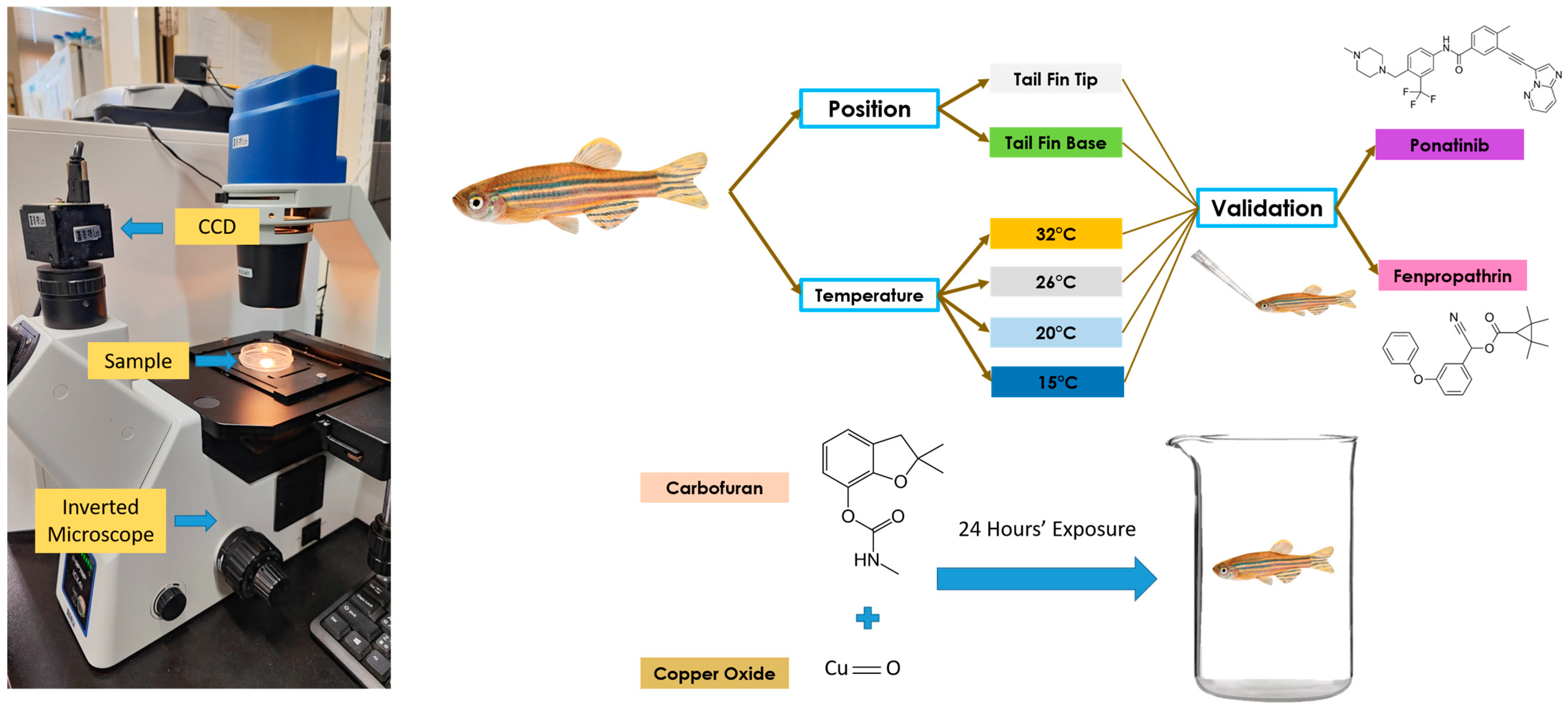
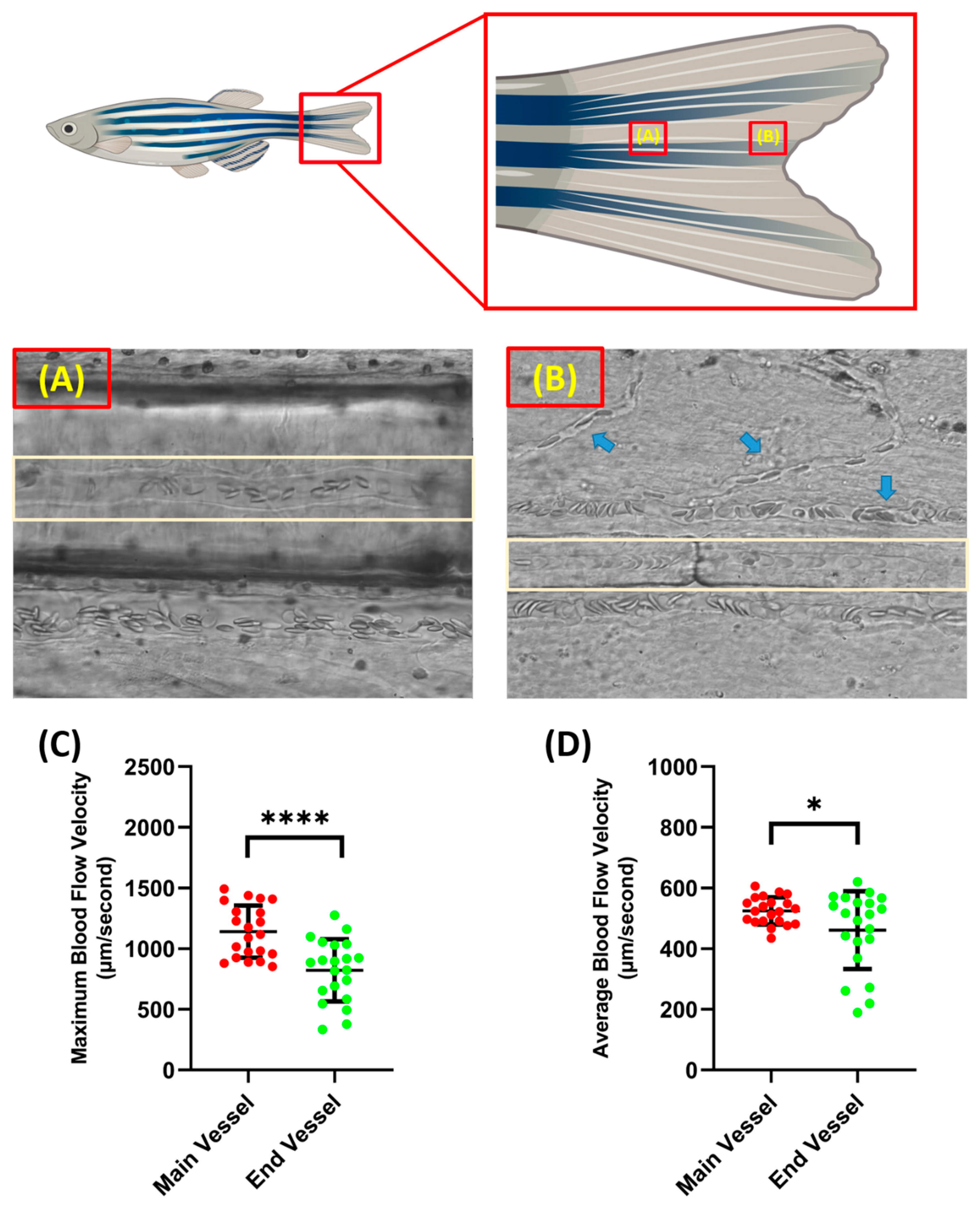


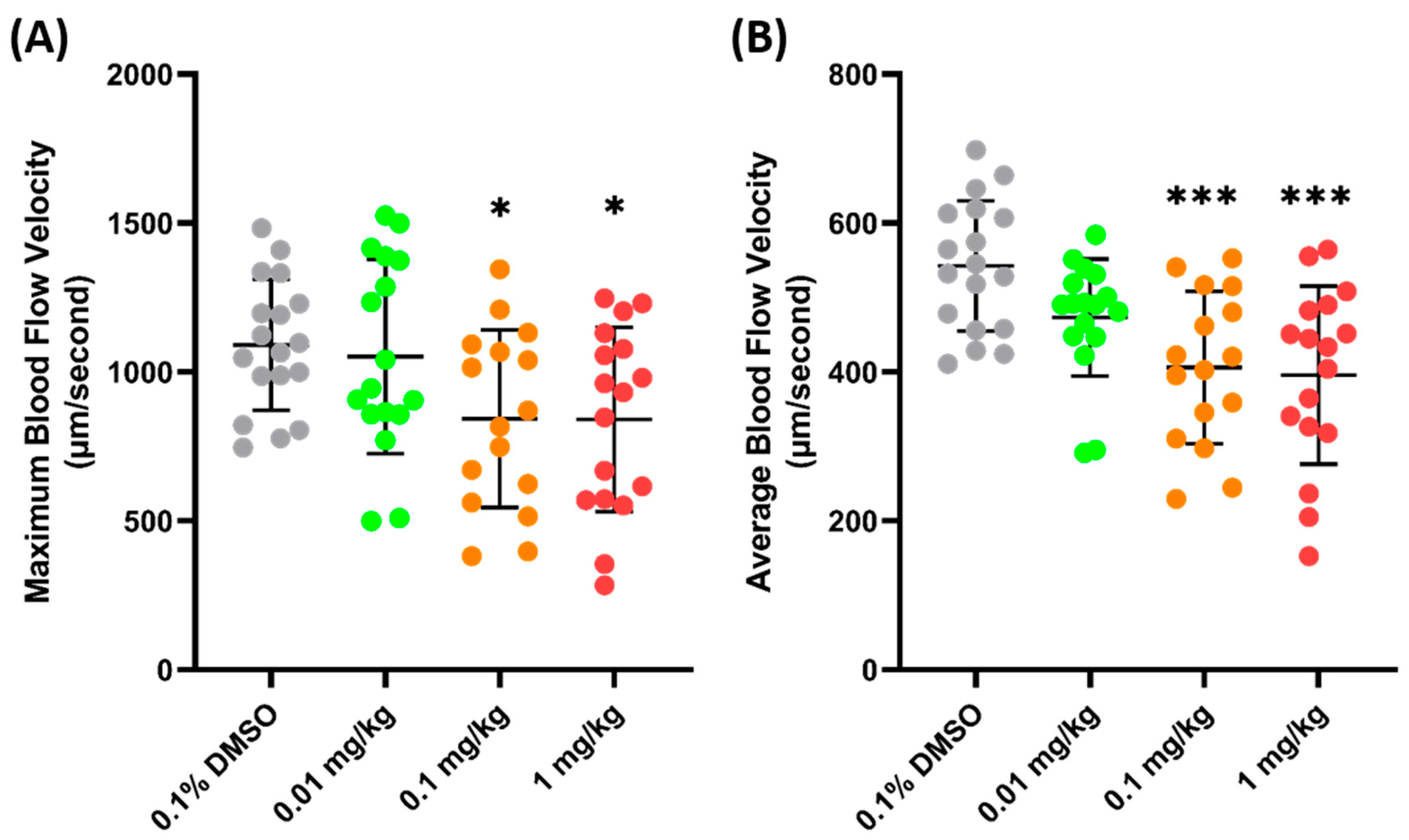
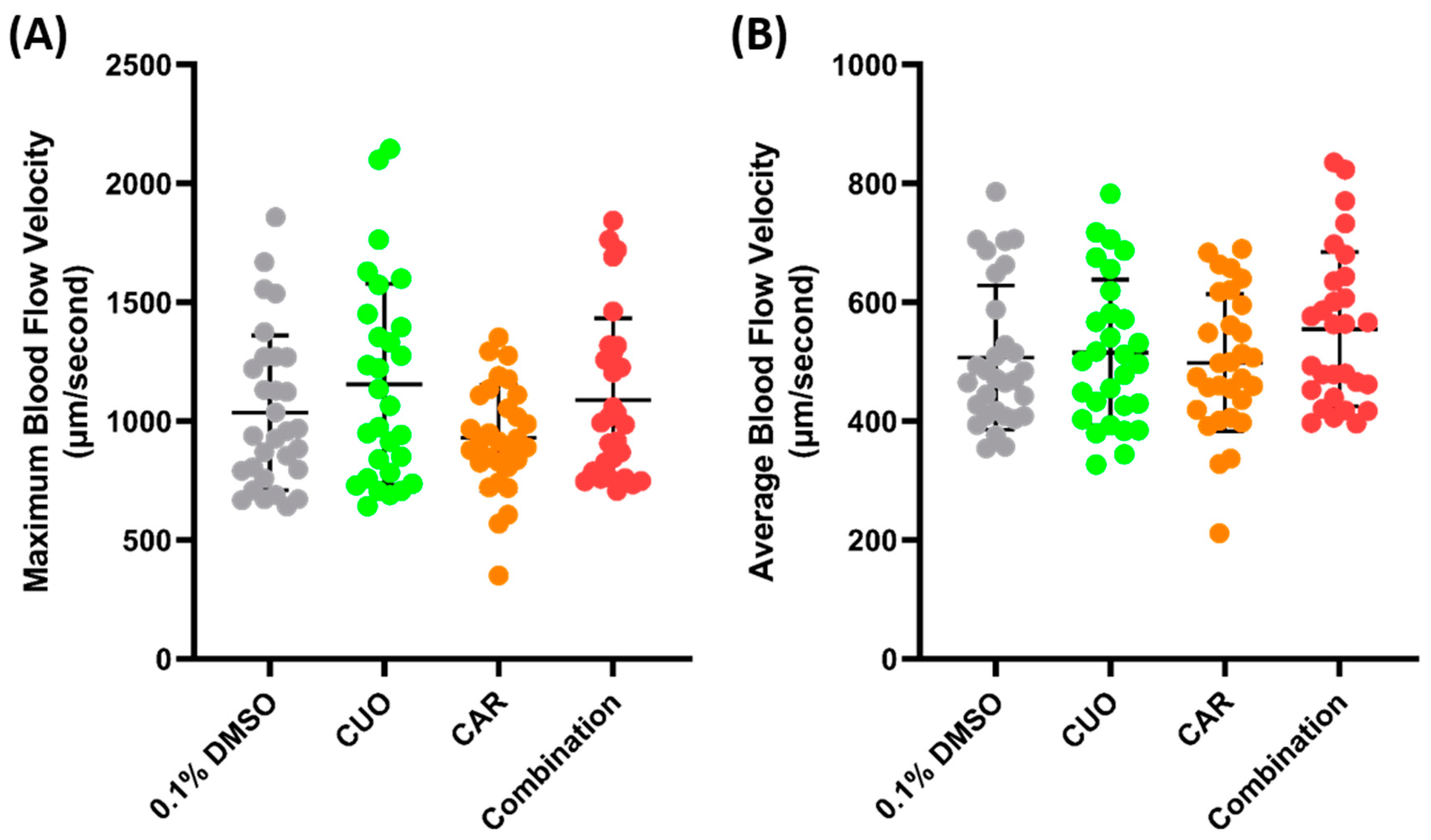
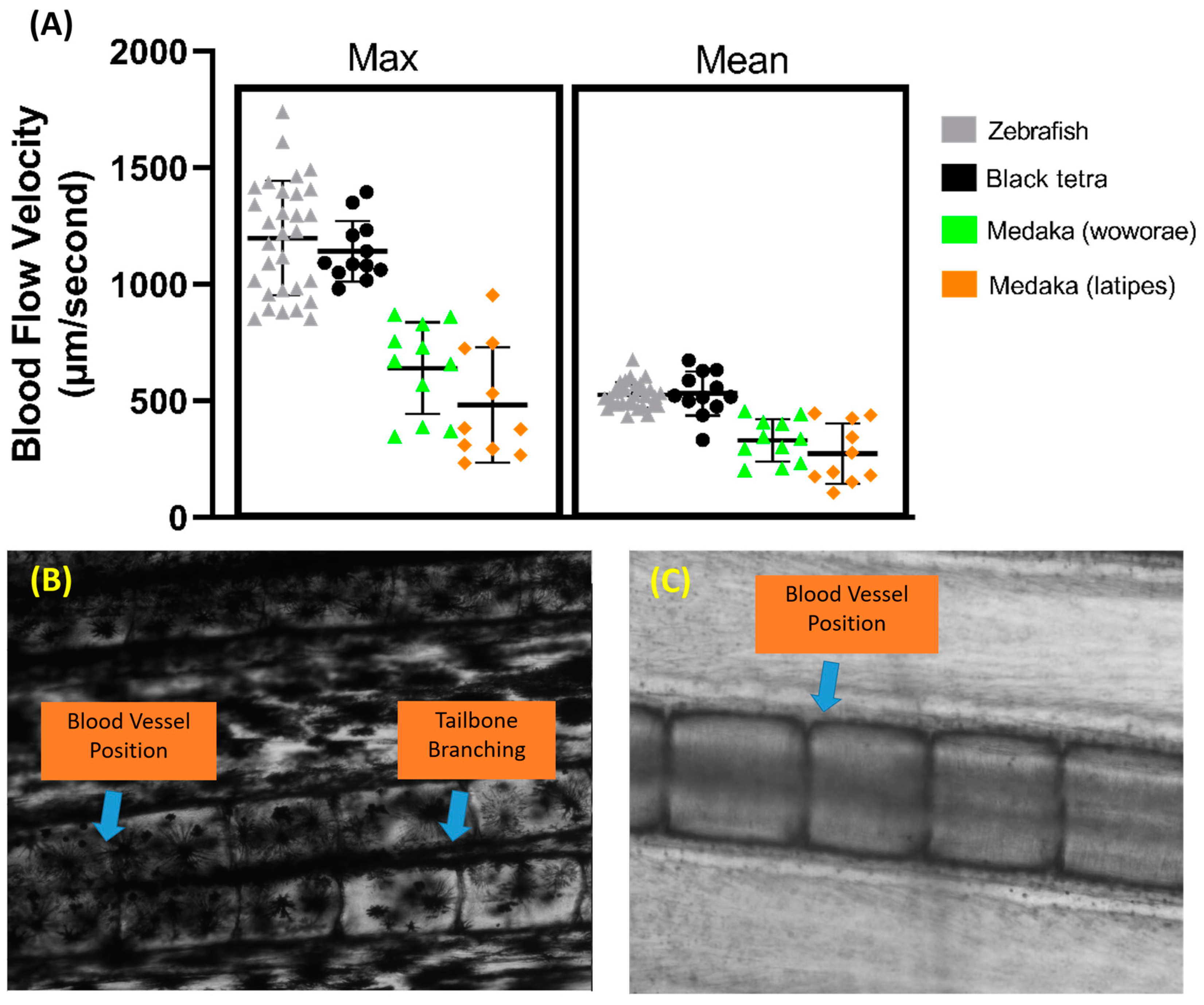
| Year | Method | Target | References |
|---|---|---|---|
| 2008 | High-frame rate duplex ultrasound biomicroscopy | Mouse and zebrafish | Xu et al. [32] |
| 2012 | Line-scannning particle image velocimetry | Mouse | Kim et al. [33] |
| 2013 | Retrospective Doppler-gated echocardiography system | Zebrafish | Liu et al. [34] |
| 2015 | High-resolution echocardiography system | Zebrafish | Huang et al. [35] |
| 2016 | Laser speckle contrast imaging | Atlantic cod | Ambrus et al. [36] |
| 2019 | High-speed video imaging | Zebrafish larvae | Santoso et al. [29] |
| 2020 | High-frequency ultrasound deformation | Zebrafish | Chiang et al. [37] |
| 2020 | Ultrasound localization microscopy | Mouse | Espindola et al. [38] |
| 2024 | Time-resolved laser speckle contrast imaging | Rodent | Faraneh et al. [39] |
Disclaimer/Publisher’s Note: The statements, opinions and data contained in all publications are solely those of the individual author(s) and contributor(s) and not of MDPI and/or the editor(s). MDPI and/or the editor(s) disclaim responsibility for any injury to people or property resulting from any ideas, methods, instructions or products referred to in the content. |
© 2025 by the authors. Licensee MDPI, Basel, Switzerland. This article is an open access article distributed under the terms and conditions of the Creative Commons Attribution (CC BY) license (https://creativecommons.org/licenses/by/4.0/).
Share and Cite
Saputra, F.; Tseng, T.-M.; Casuga, F.P.; Lai, Y.-H.; Hung, C.-H.; Hsiao, C.-D. Application of a ImageJ-Based Method to Measure Blood Flow in Adult Zebrafish and Its Applications for Toxicological and Pharmacological Assessments. Biology 2025, 14, 51. https://doi.org/10.3390/biology14010051
Saputra F, Tseng T-M, Casuga FP, Lai Y-H, Hung C-H, Hsiao C-D. Application of a ImageJ-Based Method to Measure Blood Flow in Adult Zebrafish and Its Applications for Toxicological and Pharmacological Assessments. Biology. 2025; 14(1):51. https://doi.org/10.3390/biology14010051
Chicago/Turabian StyleSaputra, Ferry, Tzu-Ming Tseng, Franelyne P. Casuga, Yu-Heng Lai, Chih-Hsin Hung, and Chung-Der Hsiao. 2025. "Application of a ImageJ-Based Method to Measure Blood Flow in Adult Zebrafish and Its Applications for Toxicological and Pharmacological Assessments" Biology 14, no. 1: 51. https://doi.org/10.3390/biology14010051
APA StyleSaputra, F., Tseng, T.-M., Casuga, F. P., Lai, Y.-H., Hung, C.-H., & Hsiao, C.-D. (2025). Application of a ImageJ-Based Method to Measure Blood Flow in Adult Zebrafish and Its Applications for Toxicological and Pharmacological Assessments. Biology, 14(1), 51. https://doi.org/10.3390/biology14010051








